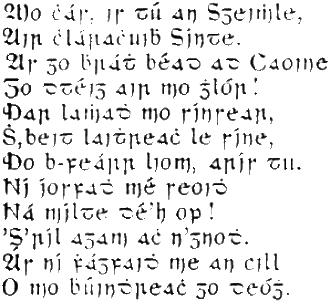Irish language

Irish (Irish: Gaeilge), also known as Irish Gaelic, is the original language of the Celtic peoples of Ireland. It is a Celtic language of the Goidelic branch, and is related to Scots Gaelic, Welsh, Manx, Cornish, and other early Celtic languages of the British Isles. While for many centuries it was the primary language of Ireland, and possesses a rich literature, it is now the natural (as opposed to the learned) language of only a small minority of the Irish people, primarily in the west of Ireland in a region known as the Gaeltacht. Nevertheless, it remains an official language of the Irish state; its teaching is mandated in public schools.
Grammar
Phonology
Phonology here refers to the sound patterns of Irish, which vary by dialect but all share certain features. Phonologists have traditionally classified most of the language's 33 or so consonants into 'broad' and 'slender' pairs, i.e. respectively velarised or palatalised, involving different placement of the tongue. This difference is phonemic: substituting one for another produces a different word, e.g. bó 'cow' and beo 'alive'. Such consonants also affect which of Irish's 15 or so vowels may acceptably co-occur with them.
Another interesting feature of Irish phonology concerns consonant clusters, i.e. sequences of consonants. Words may begin with two or three consonants, which usually agree in being broad or slender. Two-member clusters consist of an obstruent consonant followed by a liquid (e.g. pleidhce /ˈpʲlʲəicə/ 'idiot') or nasal consonant (e.g. cnaipe /ˈkn̪ˠapʲə/ 'button'); three-member clusters start with a sibilant as in sparán /ˈsˠpˠaɾˠaːn̪ˠ/ 'purse', preceding a voiceless stop and a liquid.[1] However, under consonant mutation (changing consonants according to some rule), other sequences can occur: e.g. bhlas /wɫ̪asˠ/ 'tasted', mbláth /mˠɫ̪aː/ 'flower'.[2]
| t̪ˠaː mʲeː ˈklɪʃtʲaːl ə ɡɔl haɾˠəmˠ ɡə mʲəi ˈsˠavˠɾˠə fʲlɔx sˠə ˈmʲliənə aɡən̠ʲ aɡəsˠ ˈçiːt̪ˠəɾˠ ɣɔmˠ pʲeːn ɡəɾˠ ˈaʃtʲəx ə ʃceːl eː ʃɪn
Tá mé ag cloisteáil ag dul tharam go mbeidh samhradh fliuch sa mbliana againn, agus chítear dhom féin gur aisteach an scéal é sin. 'I have heard tell that we'll have a wet summer this year, but it seems to me that that story is strange.' |
Stress
Stress is generally predictable in Irish: it is placed on the first syllable of the word, e.g. easonóir [ˈasˠən̪ˠoːɾʲ] 'dishonour'.[4] Exceptions are often adverbs or loanwords, such as amháin [əˈwaːnʲ] 'only' and tobac [təˈbak] 'tobacco'. In compund words, such as lagphórtach [ˈɫ̪agˌfˠɔɾˠt̪ˠəx] 'spent bog', primary stress falls on the first member. When a short vowel is unstressed, it generally surfaces as the schwa [ə], similar to the vowels beginning and ending the English word aroma.
Writing system
The orthography of Irish consists of the set of rules and grapheme-phoneme (sound-letter) correspondences used to write the language. From around the seventh century, Old Irish began to be written in an insular Latin script, which retained some features of the existing Ogam script. Modern Irish uses a modified Latin alphabet today.[5]